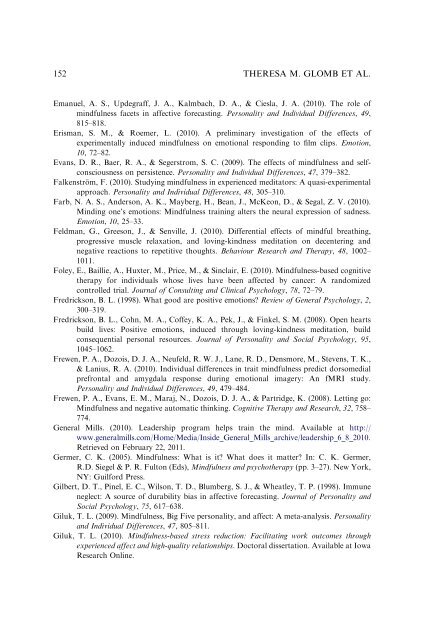Mindfulness at work (Glomb, Duffy et al, 2012) - Human Resources
Mindfulness at work (Glomb, Duffy et al, 2012) - Human Resources
Mindfulness at work (Glomb, Duffy et al, 2012) - Human Resources
Create successful ePaper yourself
Turn your PDF publications into a flip-book with our unique Google optimized e-Paper software.
152THERESA M. GLOMB ET AL.Emanuel, A. S., Updegraff, J. A., K<strong>al</strong>mbach, D. A., & Ciesla, J. A. (2010). The role ofmindfulness fac<strong>et</strong>s in affective forecasting. Person<strong>al</strong>ity and Individu<strong>al</strong> Differences, 49,815–818.Erisman, S. M., & Roemer, L. (2010). A preliminary investig<strong>at</strong>ion of the effects ofexperiment<strong>al</strong>ly induced mindfulness on emotion<strong>al</strong> responding to film clips. Emotion,10, 72–82.Evans, D. R., Baer, R. A., & Segerstrom, S. C. (2009). The effects of mindfulness and selfconsciousnesson persistence. Person<strong>al</strong>ity and Individu<strong>al</strong> Differences, 47, 379–382.F<strong>al</strong>kenström, F. (2010). Studying mindfulness in experienced medit<strong>at</strong>ors: A quasi-experiment<strong>al</strong>approach. Person<strong>al</strong>ity and Individu<strong>al</strong> Differences, 48, 305–310.Farb, N. A. S., Anderson, A. K., Mayberg, H., Bean, J., McKeon, D., & Seg<strong>al</strong>, Z. V. (2010).Minding one’s emotions: <strong>Mindfulness</strong> training <strong>al</strong>ters the neur<strong>al</strong> expression of sadness.Emotion, 10, 25–33.Feldman, G., Greeson, J., & Senville, J. (2010). Differenti<strong>al</strong> effects of mindful bre<strong>at</strong>hing,progressive muscle relax<strong>at</strong>ion, and loving-kindness medit<strong>at</strong>ion on decentering andneg<strong>at</strong>ive reactions to rep<strong>et</strong>itive thoughts. Behaviour Research and Therapy, 48, 1002–1011.Foley, E., Baillie, A., Huxter, M., Price, M., & Sinclair, E. (2010). <strong>Mindfulness</strong>-based cognitiv<strong>et</strong>herapy for individu<strong>al</strong>s whose lives have been affected by cancer: A randomizedcontrolled tri<strong>al</strong>. Journ<strong>al</strong> of Consulting and Clinic<strong>al</strong> Psychology, 78, 72–79.Fredrickson, B. L. (1998). Wh<strong>at</strong> good are positive emotions? Review of Gener<strong>al</strong> Psychology, 2,300–319.Fredrickson, B. L., Cohn, M. A., Coffey, K. A., Pek, J., & Finkel, S. M. (2008). Open heartsbuild lives: Positive emotions, induced through loving-kindness medit<strong>at</strong>ion, buildconsequenti<strong>al</strong> person<strong>al</strong> resources. Journ<strong>al</strong> of Person<strong>al</strong>ity and Soci<strong>al</strong> Psychology, 95,1045–1062.Frewen, P. A., Dozois, D. J. A., Neufeld, R. W. J., Lane, R. D., Densmore, M., Stevens, T. K.,& Lanius, R. A. (2010). Individu<strong>al</strong> differences in trait mindfulness predict dorsomedi<strong>al</strong>prefront<strong>al</strong> and amygd<strong>al</strong>a response during emotion<strong>al</strong> imagery: An fMRI study.Person<strong>al</strong>ity and Individu<strong>al</strong> Differences, 49, 479–484.Frewen, P. A., Evans, E. M., Maraj, N., Dozois, D. J. A., & Partridge, K. (2008). L<strong>et</strong>ting go:<strong>Mindfulness</strong> and neg<strong>at</strong>ive autom<strong>at</strong>ic thinking. Cognitive Therapy and Research, 32, 758–774.Gener<strong>al</strong> Mills. (2010). Leadership program helps train the mind. Available <strong>at</strong> http://www.gener<strong>al</strong>mills.com/Home/Media/Inside_Gener<strong>al</strong>_Mills_archive/leadership_6_8_2010.R<strong>et</strong>rieved on February 22, 2011.Germer, C. K. (2005). <strong>Mindfulness</strong>: Wh<strong>at</strong> is it? Wh<strong>at</strong> does it m<strong>at</strong>ter? In: C. K. Germer,R.D. Siegel & P. R. Fulton (Eds), <strong>Mindfulness</strong> and psychotherapy (pp. 3–27). New York,NY: Guilford Press.Gilbert, D. T., Pinel, E. C., Wilson, T. D., Blumberg, S. J., & Whe<strong>at</strong>ley, T. P. (1998). Immuneneglect: A source of durability bias in affective forecasting. Journ<strong>al</strong> of Person<strong>al</strong>ity andSoci<strong>al</strong> Psychology, 75, 617–638.Giluk, T. L. (2009). <strong>Mindfulness</strong>, Big Five person<strong>al</strong>ity, and affect: A m<strong>et</strong>a-an<strong>al</strong>ysis. Person<strong>al</strong>ityand Individu<strong>al</strong> Differences, 47, 805–811.Giluk, T. L. (2010). <strong>Mindfulness</strong>-based stress reduction: Facilit<strong>at</strong>ing <strong>work</strong> outcomes throughexperienced affect and high-qu<strong>al</strong>ity rel<strong>at</strong>ionships. Doctor<strong>al</strong> dissert<strong>at</strong>ion. Available <strong>at</strong> IowaResearch Online.


